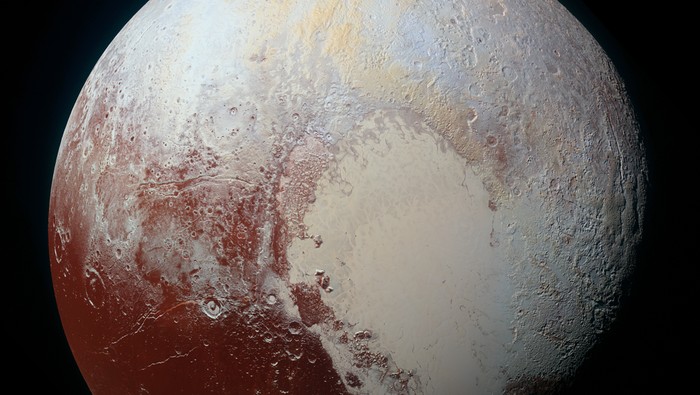Until 2006 it was the last planet of the solar system. It belongs today to the family of the dwarf planets because its characteristics are too different from those of the other planets. Pluto moves in an inclined and very elongated orbit that varies between 4.3 and 7.4 billion km from the Sun, so that for 20 years it is in front of Neptune! From so far away the Sun looks almost like a star and shines 1500 times less than on Earth! Pluto is so distant that even the light that travels very fast, at 300000 km/s, takes more than 4 hours to reach it!
Pluto is half smaller than Mercury with a diameter of only 2370 km and a mass 5 times smaller than that of the Moon. Pluto is surrounded by 5 satellites. The most brilliant is Charon, which was discovered in 1978. It measures 1208 km in diameter. Given its red color, it is probably a small asteroid that was captured by Pluto. This satellite has a synchronous rotation, that is to say that it always remains in the same place in the sky relative to the planet. The last satellites were discovered in 2005 thanks to the Hubble Space Telescope.
Unfortunately, lost in the confines of the solar system, Pluto undergoes a permanent winter plunging its surface by -220° C. So far and so small we do not have many images of Pluto or its satellite that often look like little stars in the sky. That’s why the scientists pressed NASA to agree to launch a space probe to Pluto to photograph and analyze it.
The New Horizons mission was launched in 2006. Crossing the solar system at more than 49,000 km/h, after a journey of 5 billion kilometers, the spacecraft finally reached Pluto on July 14, 2015, revealing a small celestial body while in shades of brown, covered with plains and icy mountains but with relatively few craters compared to other stars.
Now the New Horizons probe continues its journey to the Kuiper Belt where there are asteroids (KBO and other TNO) as well as comet nuclei that it should reach in 2026.


hj
a
a
a
j
s
T